The Shadow of the United States in Yemen
This paper was written as part of my International Security Studies master’s thesis while attending the University of Arizona.
Introduction
The state of Yemen has become the most recent battleground in the War on Terror. Within this conflict the splinter group Al-Qaeda in the Arabian Peninsula (AQAP) has emerged as a significant threat to both the Yemeni government and the United States of America. Yemen has lost physical territory to AQAP while being subject to numerous attacks and the US has had close calls with the ‘Christmas bomber’ and printer bombs. The US and Yemen have not been idle to these threats and have dramatically shifted their level of action within the region in recent years.
However, these actions have proven ineffective and sometimes even counterproductive to effectively combating the danger and abilities of AQAP. The shadows of US foreign aid constraints on the Yemeni government are counterproductive to effectively combating AQAP and undermine the capabilities of the Yemeni state. An important part of this deduction comes from the analysis of state actions and their influences on civilians within the conflict between AQAP, Yemen, and the US. For instance, the utilization of mass arrests by Yemeni officials to meet US foreign aid requirements have only increased animosity towards the state government without accomplishing any counterterrorism measures. Such misconduct has done large amounts of damage to the domestic will in fighting AQAP. Much of the conduct of the Yemeni government has shown a near disregard for the domestic impact of some actions while focusing hypocritically on securing packages of international aid and military support. This is due to the massive importance of US foreign aid to the Yemeni national government. Another area of domestic erosion of political support is the prevalence of drone strikes carried out by the US in combating AQAP. Due to the prevalence of innocent civilians killed in such attacks the claims by US officials in dismantling AQAP are actually regressing. This could be due primarily to the ‘accidental guerilla’ phenomenon, as outlined by David Kilcullen. Current levels of foreign aid and military support are helping Yemen in many ways but not in its ability to effectively combat and suppress the actions of AQAP.
Before approaching the immense domestic complications within Yemen a brief understanding of its formative history is helpful in understanding the perspective of Yemeni citizens, at least in the most general of terms. This explanation brings up many of the problems Yemen faces today including broad poverty, the southern separatists, and the northern rebellion. The southern secessionist movement is almost entirely understood through the division of north and south Yemen before unification in 1990. Thereafter, an introduction to the origins of al-Qaeda before the regional AQAP splinter group became dominant is helpful in seeing the necessity and justification of a US response. This subject closely brings into focus the critical importance of the relationship between US foreign aid and its constraining influence on domestic Yemeni politics. These constraints are shown through the examples of false mass imprisonment and the US drone strike campaign conducted within Yemen. The constraints of US foreign aid are largely due to the immense economic problems facing Yemen that will only worsen with falling production of oil, a primary industry in Yemen.
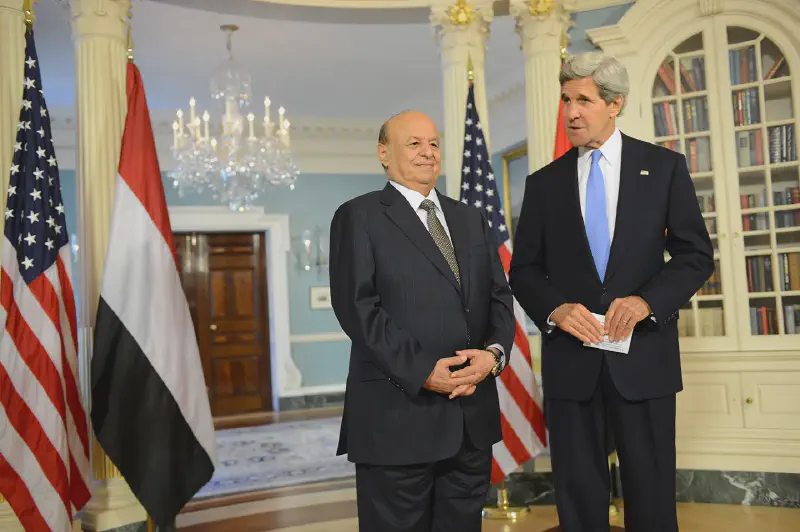
U.S. Secretary of State John Kerry and Yemeni President Abdo Rabbo Mansour Hadi address reporters before their bilateral meeting at the U.S. Department of State in Washington, D.C., on July 29, 2013. U.S. Department of State
History of Yemen
It was not until 1990 that the Republic of Yemen became a one state. Throughout most of its history, Yemen has ruled itself through the practice of tribalism despite the presence of Islamic dynasties and several empires (Sharp 2012, 2). Yemen’s rugged terrain and thin concentration of people has historically isolated much of the country from domination by a single political entity. This was to change, however, in the 1900s when much of the Arab world was experiencing substantial political changes, which subsequently split Yemen into two distinct polities. In the north, the Yemen Arab Republic took control from the Yemeni Imamate and in the South a movement of Marxists succeeded in establishing their own state (Sharp 2012, 3). These separate states existed until their eventual unification in 1990, which was thereafter governed by Ali Abdullah Saleh, a long time ruler of northern Yemen (Sharp 2012, 3). As with many other rulers throughout the Arab world, Saleh maintained power for a number of years until the events of the Arab Spring.
In conjunction with the Egyptian revolution and the Tunisian revolution, the Yemeni revolution of 2011 heavily transformed the nation. Set off by both incidents in Tunisia and Egypt, Yemeni citizens began to demonstrate on a large scale in early 2011. According to the BBC, these mass protests were calling for lower unemployment, better economic conditions, protection for the constitution, and for longtime President Ali Abdullah Saleh’s resignation (Sinjab 2011). Reflective of the greater Middle Eastern region, deep poverty and limited economic options prompted the large protests in Yemen. The chronic problems of “economic recession, staggering poverty, dwindling oil and water resources, rapid population growth, and low literacy rates’’ all contributed to a severely dissatisfied population (Hellmich 2012, 624). These reasons initially drew ten thousand protestors calling for Saleh’s resignation and eventually grew to twenty thousand protestors when Saleh did not immediately resign (Sinjab 2011). Saleh dismissed calls for his resignation, which led to fighting between various factions and the eventual bombing of the Presidential compound, injuring Saleh and forcing him to leave the country for medical attention.
In the power vacuum that resulted in Saleh’s absence, multiple factions, including the Houthi rebellion in the north, the Southern Movement, and AQAP all gained substantial territory while the numerous factions within the central government were occupied with post-Saleh power scrambles. As the pressure to resign continued, Saleh eventually signed a thirty-day transfer of power to then Vice President al-Hadi. Thereafter, elections were held and al-Hadi was elected as the new president. Rather than heralding a new era of Yemeni politics, President al-Hadi signaled a continuation of the status quo, as he was the only candidate on the ballot (Hellmich 2012, 623). Despite these political troubles, a new government in Yemen has the potential to depart from past practices of political corruption that have soured its domestic image. Much of the population questions the legitimacy of the central government after seeing a large influx of foreign aid that more than often only benefited the elite (Winter 2010, 400). The legitimacy of the central government can be restored if reforms are implemented to correctly handle the numerous problems the Yemeni people face. One such problem includes the tattered national economy that is undiversified and dependent on a single resource. As one of the poorest states in the Middle Eastern region, Yemen faces a variety of additional financial problems, including poverty, impending lack of oil, and a weak central government. Nearly half of the state’s 23 million people survive on less than two dollars per day (Ghobari and Sudam 2011) and around forty percent of Yemenis are unemployed (Plaut 2008). Ninety percent of Yemen’s exports are from oil, a resource that has been forecasted by the World Bank to run completely dry in Yemen within the next decade.
Other problems facing Yemen are far more politically violent and incessantly drain the national treasury and national political will. The history of being two separate states has played a central role in creating these modern divisions within the state of Yemen. Once the Republic of Yemen became a unified state, the northern polity began to marginalize the southern region. Much of southern Yemen still views their “political, economic, and cultural” lives as being dominated by northern interests and personnel (Sharp 2012, 3). This has given rise to the South Yemen Movement, which seeks secession from the Republic of Yemen after its marginalization following the 1990 unification and 1994 civil war. Deep concerns were voiced by Vice President Salim al-Beidh following Yemeni unification due to subsequent violence and the strong marginalization of the south (“Yemen Profile”). President Saleh soon after dismissed Beidh. Beidh and other supporting parties declared independence from the Republic of Yemen in May of 1994, an action Saleh declared illegal (“Yemen Profile”). The Republic of Yemen successfully invaded South Yemen and retook all of the territory while Southern leaders were “sentenced to death in absentia” (“Yemen Profile”). The South Yemen secessionist movement found little support for years after the civil war and only reentered the public psyche during the Arab Spring events of 2011.
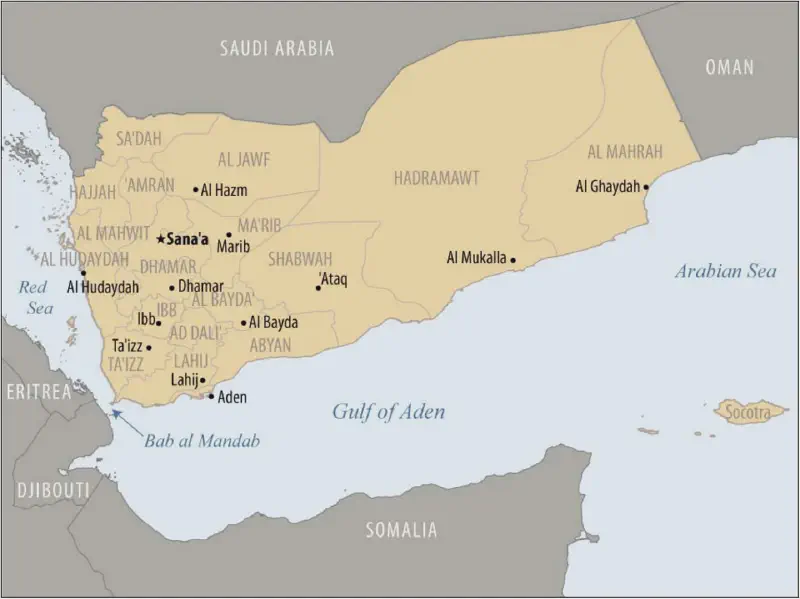
Map of Yemen. Source: Map Resources. Adapted by Congressional Research Service (July 2010).
The secession of an entire southern region from Yemen is not the only rebellion the central government of Yemen faces. Another breakaway group that was driven into existence by a disagreement with state actions was the Houthi rebellion in North Yemen during 2004. Hussein al Houthi was the founder of the Houthi rebellion and advocated against Yemeni support for the United States’ War on Terror. Upsetting a key ally that was providing large sums of financial aid was not something the Saleh regime could adopt. During intense fighting and security operations in mid-2004, Hussein al Houthi was killed; however, his death only incensed the Houthi movement. Since 2005 the Houthi rebellion has numbered from one thousand fighters to an upward estimate of ten thousand in 2009 (Redwan 2012). When including non-operational supporters for the Houthi rebellion, this number increases dramatically. Ahmed Al-Bahri, an expert on Houthi affairs, has stated the number of Houthi followers as, “loyalists or fighters” range between 100,000 to 120,000 (Almasmari 2010). The Houthi rebellion is a deadly threat to the central government and killed an estimated 1,000 Yemeni security personnel between 2004 and 2008 (Freeman 2009, 1013). Moreover, between 250,000 and 350,000 people have been displaced within Yemen due to the Houthi rebellion (Hellmich 2012, 624). The degree to which this has influenced the state is tremendous. With a population of approximately twenty-four million, nearly half a million displaced individuals have proven a severe financial burden for the state government and humanitarian organizations. Ongoing military operations also add to the drain on resources that could be used much more effectively elsewhere. The chances of the conflict being resolved are tenuous at best as, “periodic cease-fires have been marred by intermittent skirmishes and mutual recriminations” (Winter 2010, 397). Such a poor progression into peace is not strictly limited to the Houthi rebellion and is a highlight of the final insurgency that is explored in this paper.
History of Al-Qaeda and Al-Qaeda in the Arabian Peninsula
The formation of the modern terrorist group al-Qaeda is a result of the actions of a single, wealthy man. Born in 1957 in Saudi Arabia as a son to a wealthy construction magnate, Osama bin Laden, according to Kenneth Katzman, “adopted militant Islamist views” while at university in Jeddah, where he graduated with a Civil Engineering degree (2005, 1). During the Soviet invasion of Afghanistan in the late 1970s, bin Laden, seeing an unjustified incursion on an Islamic nation, attempted to fund many of the Afghani freedom fighters with his own money (Katzman 2005, 1). In order to continue and reinforce this funding of Afghani mujahideen bin Laden sought to establish an international network of financial aid. This network was called Maktab al-Khidamat, which many consider to be the “organizational forerunner of al-Qaeda” (Katzman 2005, 2). At the cessation of the Soviet invasion of Afghanistan this network numbered between 10,000 to 20,000 operatives (Katzman 2005, 2). With the framework in place all that was needed was to operationalize many of the supporters of Maktab al-Khidamat. With the threat of Soviet incursion ending in Afghanistan, bin Laden’s mentor, Abdullah al-Azzam, urged the necessity of a “base” Islamic “rapid reaction force” (Katzman 2005, 2). This force would be able to respond worldwide to any perceived threat to Islamist people.
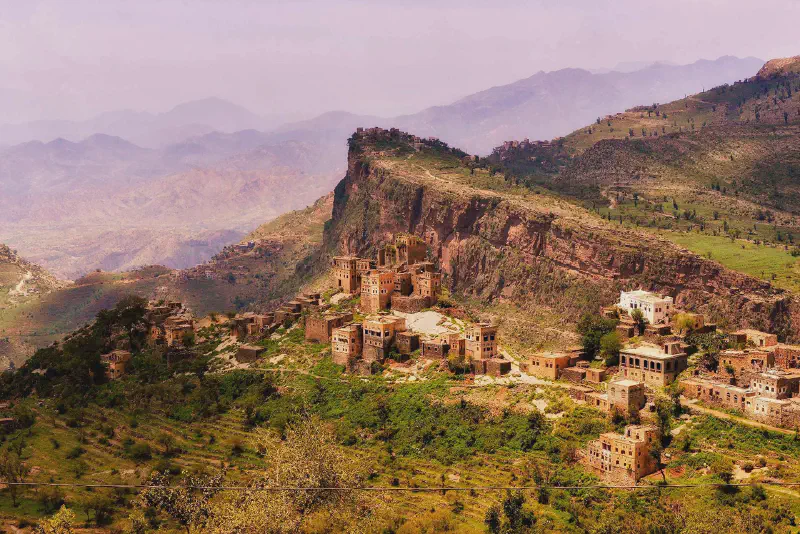
Yemen countryside. Source: Rod Waddington
Such a rapid reaction force was not on the radar of the United States. The mujahideen fighting the Soviet occupation of Afghanistan were actually being supported by the US. By supplying stinger missiles and other means of support to freedom fighters the US was able to fight a proxy war against the Soviets. Even after the collapse of the Soviet Union the threat of Islamic fundamentalists was not piquing US security interests. In 1995 President Bill Clinton even signed Executive Order 12947 imposing sanctions on 12 terrorist factions that had stalled Middle East peace efforts that did not include bin Laden (Coll 2004, 277). This peaceful relationship would, however, change with the bombings of US embassies in Kenya and Tanzania in 1998 that killed roughly 300 people (Katzman 2005, 4). The change of bin Laden’s perception to motivate such an attack came through his perspective that the US tainted Saudi and Kuwaiti soil with their presence during the First Gulf War. In his logic, after offering aid to mujahideen fighters in Soviet Afghanistan the US was now guilty of the same sin in the Arabian Peninsula as the Soviets had been in Afghanistan, by interfering with Muslim populations.
Al-Qaeda had been active within the region and Yemen before the formation of AQAP itself. An instance of terrorism in the area was the bombing of the USS Cole in 2000. Operatives killed 17 sailors and critically crippled a warship costing nearly a billion dollars with only a small watercraft laden with explosives (Johsen 2013, 72). Less than a year later the attacks of September 11, 2001 charged the US endeavor of bringing members of al-Qaeda to justice with a great deal more haste.
The history of AQAP lies in the mirrored regionalization of the original al-Qaeda terrorist group. Al-Qaeda operated in Yemen and the surrounding region far before the USS Cole attack in 2000. Other bombings and suicide attacks occurred in the region until 2005 when much of al-Qaeda was presumed to have been decimated by US military and ally efforts. It was not until about four years later in 2009 that a video showed a declaration that a reemerged al-Qaeda in the region had formed into a concrete threat. Formally, AQAP was created by Abd al-Karim al-Wahayshi in a January 2009 announcement wherein he declared the Saudi Arabia and Yemen branches of al-Qaeda formed into AQAP (Hellmich 2012, 619). By consolidating the two groups, al-Wahayshi was able to secure power, increasing the effectiveness of pursuing regional goals. The new leader of a newly minted AQAP pledged to target Yemeni, Saudi Arabian, and Western interests within a regional and international context (Hellmich 2012, 619). These goals reflected many of al-Qaeda’s original pursuits but translated to a regional scale. Such parallels would seem inevitable considering many of AQAP’s members were originally part of al-Qaeda. Al-Wahayshi himself was originally an understudy to Osama bin Laden (Johnsen 2013, xv) and garnered much of his power through that past proximity. AQAP could therefore be considered a ‘franchise’ of the al-Qaeda parent company. This franchise has been thought to number among 200 to 300 members (Hellmich 2012, 621) and up to 1,000 (Ackerman and Shactman 2012). Ultimately, however, the most critical number of AQAP members is what the US deems a security threat. A defined number could carry the reinforcement or the retraction of substantial US domestic and military aid.
Impact on State Belligerents
Besides the previously mentioned vicious attack on the USS Cole other terrorist plots have been intended for US audiences. A notable example was the purported ‘underwear bomber’ or ‘Christmas bomber,’ Umar Farouk Abdulmutallab’s attempt to bomb flight 253 in 2009. Kate Stanton notes that multiple reports sourced Umar’s training as having originated from AQAP in Yemen (2010). Another plot was attempted by hiding explosives in the ink cartridges of printers during their transport on a cargo plane. Although unsuccessful, the attempted international reach of AQAP has alarmed many US policy-makers. According to some US intelligence officers AQAP incorporates the “greatest threat to America” (Cloud and Dilanian 2012). Additionally, some CIA analysts perceived AQAP as such an “urgent threat” to US national security in 2010 they urged officials to call for expanded operations in Yemen and increase military aid to $1.2 billion (Hellmich 2012, 618). However, such large financial investments would be difficult to appropriate in an environment already filled with Afghanistan, Iraq, and other counterterrorism projects. Additionally, an infusion of cash could further complicate the motivations the Yemeni government would pursue in abusing their citizens in attempts to garner more foreign aid. These concerns were ultimately overcome.
Foreign Aid and Yemen
In order to understand some of the unusual measures taken by Yemen in reaching anti-terrorism goals we must review its history of international aid. Massive dragnet arrests at the urging of a foreign power do not exemplify normal state behavior but show the dedication of Yemeni leaders in obtaining external financial support. Foreign aid is critical to Yemen, in subsidizing the historically poor nation state and without it, Yemen would face a bleak situation on all fronts. The below World Bank graph shows the historical volatility of net official development assistance received by Yemen as noted in billions of U.S. dollars (2014).
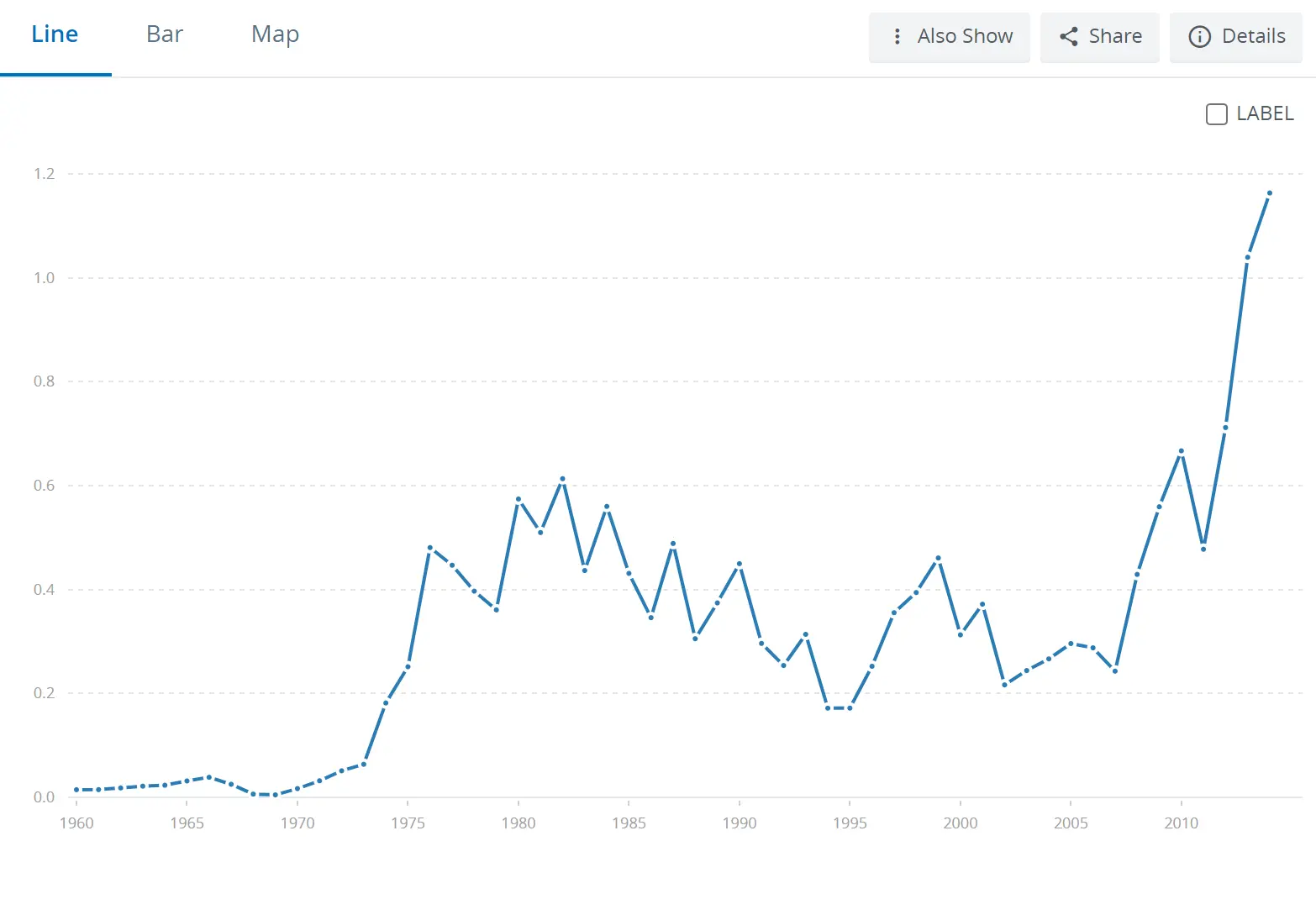
Although Yemen was not actually a state until 1990 the sovereign actors occupying its geographical space have been receiving aid since the 1960s. The current extreme aid relationship between the US and Yemen is truly anomalous in comparison to historical trends. According to Sheila Carapico, “the US never invested heavily in Yemen, nor have the Yemenis seen the US as a benefactor” (2006, 185). Carapico goes on to state that the past aid relationship Yemen had with other states was a lot stronger and between 1968-1980 amounted to $150 million from the USSR and $84 million from China (2006, 185). This again was dwarfed by OPEC states giving $399 million between 1973-1981. The two primary reasons for such foreign aid was the political solidarity from the USSR and China with the socialist South Yemen state and “as part of [Saudi Arabia’s] regional anticommunist strategy” (Carapico 2006, 193). As global politics began to shift in the early 1990’s the promise of socialist support began to fade with the collapse of the USSR and the immense test of the First Gulf war came upon Yemen.
It was during the First Persian Gulf War in which Yemen gambled foreign aid support in what it believed a more appropriate course of action: by remaining neutral in the Iraq-Kuwait conflict (Cleveland and Bunton 2009, 494). Yemen was a rotating member of the Security Council when the United States was trying to pass resolution 678 in the United Nations, to secure the state of Kuwait from Iraqi invaders. Resolution 678 was the fundamental legal justification for the Allies to intervene under international law. When the issue came up for a vote, Yemen vetoed resolution 678 in favor of abstaining from military intervention in the Iraq-Kuwait conflict and instantly drawing the ire of the United States. Shortly after the vote, a high level US diplomat told the Yemeni diplomat, “this was the most expensive no-vote you ever cast” (Hellmich 2012, 625). Before Resolution 678, the US was giving Yemen a “token” $30 million in aid per year (Carapico 2006, 195). While not substantial in its own right the immense influence of the US on other institutions and states formed the hammer that would fall on Yemen. The US subsequently withdrew foreign aid from Yemen and advised other nations and organizations to do the same, as a punitive measure.
The opposition to Resolution 678 certainly cost Yemen dearly. Within days the United States “stopped its $70 million aid program to Yemen” while the “World Bank and the International Monetary Fund moved to block loans to the country” (Hellmich 2012, 625). Besides large Western organizations, a few of the regional powers within the Middle East punished Yemen in order to maintain the support of the United States. Saudi Arabia expelled more than eight hundred thousand Yemeni workers. Meanwhile, fellow Gulf States followed suit by expelling an additional fifty thousand Yemeni workers cumulatively (Cleveland and Bunton 2009, 494). This had a huge impact on Yemen’s economy. Up to a million workers were employed in Saudi Arabia during the 1980s and “their remittances accounted for over 40 percent of the gross domestic product of both North and South Yemen” (Cleveland and Bunton 2009, 494). Despite the fact that Yemen could never have stopped the First Persian Gulf War, it did not save it from the profound financial ire of a severely displeased US.
The waning level of foreign aid in 2005 illustrates a more contemporary occurrence of the foreign aid relationship Yemen had with the US. After tactically striking some of the key leadership of al-Qaeda in Yemen during the period between 2001-2005 the US dismissed any further need to pursue AQAP due to its limited threat.
As the level of perceived threat from Yemen diminished, so did the amount of foreign military and domestic aid. Aid to Yemen dried up as the US cut its $20 million aid program and the World Bank downsized its aid package from $420 to $280 million (Hellmich 2012, 626). As one Yemeni expert has stated, “without al-Qaeda, Yemen was just one more poor country” (Johnsen 2013, 186). If a state did not contain a security threat related to international terrorism in the post 9/11 world the US diminished some of the more ‘basic’ struggles, such as civil war and rebellion. This was especially difficult for Yemen considering the heightened status that al-Qaeda brought to US security interests and military spending in the region. Following 9/11 the US aid amount given to Yemen in combating terrorism was strong but diminished in 2005 due to less terrorist threats.
The modern relationship between the US and Yemen has recovered from this lull during the middle 2000s. Aid to Yemen in the fiscal year 2012 amounted to a staggering $356 million among a wide range of US agencies and accounted for the largest aid amount to Yemen ever (Sharp 2012, 14). Current aid in the fiscal year 2014 amounts to $142.6 million so far (Sharp 2014, 11). Please note that totals within report GAO-12-432R for FY2012 and FY2013 are incomplete.
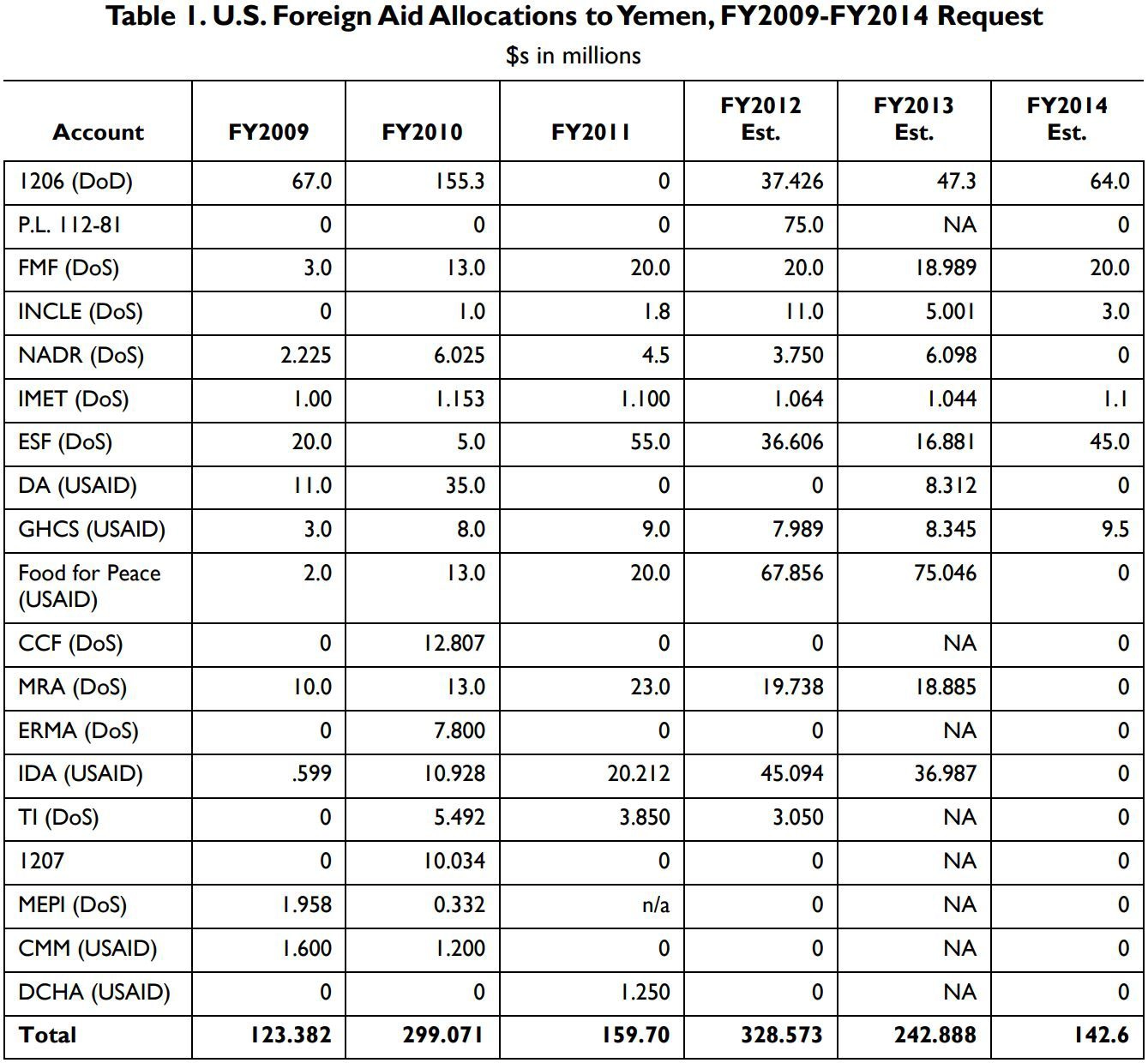
This trend of increasing aid has been on the rise since the fiscal year 2007 due mainly to the dire straits of Yemen’s domestic scene and the threat of AQAP to regional and international affairs. From fiscal year 2007 to 2013, US aid in the millions has been, $61.914 in 2007, $26.296 in 2008, $123.382 in 2009, $299.071 in 2010, $159.70 in 2011, $316.48 in 2012, and $256 tentatively in 2013 (Sharp 2012, 20). Once again, please note GAO-12-432R has incomplete amounts for FY2012.
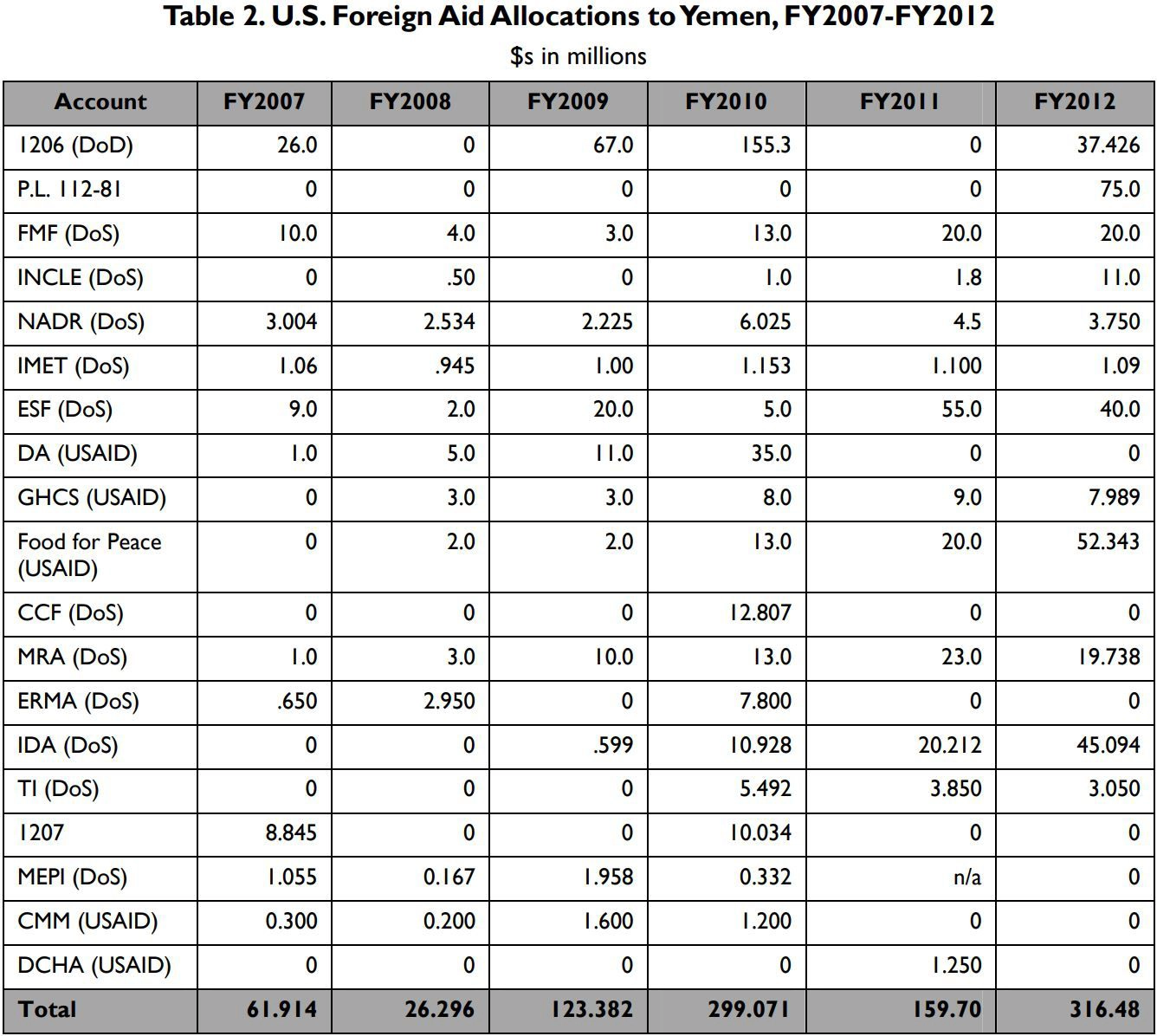
In addition to the US other states contribute Yemen in an effort to stabilize its humanitarian situation. These states formed the ‘Friends of Yemen Group’ and moved to distribute $5.7 billion in aid to Yemen that had been pledged previously in 2006 (Sharp 2012, 12). Despite the vast amounts of money pouring into Yemen the kleptocratic tendencies and corruption of state officials will result in most of the money never helping the average citizen.
With the large amount of aid going into Yemen it is necessary to note the effects of foreign aid on Yemen. Some critics focus on the potential for exploitation in the security field. If the nations giving aid to Yemen view their relationship from the perspective of security, Yemeni officials will continually exploit this fear for financial and political gain (Hill 2010, 10). However, the aid going into Yemen is not limited to security. Much of the humanitarian and investment aid Yemen receives is critical for Yemen’s future development, according to the international community and the Yemeni government (al-Shamahi 2012). Without much of the aid the US sends to Yemen the state would face profound domestic problems in addition to crippling potential future plans that are dependent on foreign aid. This dependency is dangerous, as declared by a 60% majority motion in a meeting of Yemeni citizens in 2012 (al-Shamahi). In this meeting the use of foreign aid by the Yemeni government caused more harm than good. While not representative of an entire society, such a declaration nonetheless signals that a segment of the population has recognized problems. The shadow of US foreign aid in Yemen has certainly demonstrated its constraints on the domestic actions of the Yemeni government. Despite these necessities the Yemeni dependency on foreign aid is rather obvious. Such a relationship is highlighted in its potential abuse in gaining additional aid by exaggerating security threats.
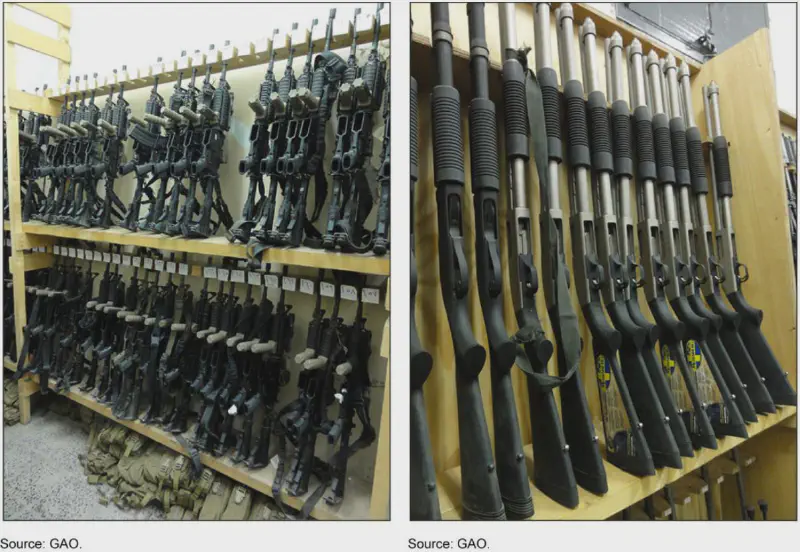
Weapons Provided to MOI through DOD’s Section 1207(n) Assistance Program. GAO-13-310. Publicly Released: Mar 20, 2013.
The central government of Yemen has a categorical incentive to continue the level of aid. Unfortunately, this has led to many analysts to conclude that Yemen is intentionally keeping conflicts, specifically the Houthi rebellion, as unresolved in order to secure international aid (Winter 2010, 400). A similar skepticism is shared of the Yemeni government’s relationship with AQAP, given that US aid is contingent upon fighting the terrorist group (Hellmich 2012, 621). More specifically, if Yemen was to meet artificial ‘progression levels’ set by external actors the state could secure foreign aid but at the expense of domestic legitimacy. Rather than focusing on domestic support that could ultimately be more valuable in fighting an insurgency the state has sourced its power to external actors. The Yemeni government can only operate within the parameters of external foreign aid and would likely collapse with all external aid cut off.
Many of these domestic consequences are already manifesting themselves as complications within the national politics of Yemen. Even with current sustained levels of international aid Yemen is still one of the poorest Arab world states. In 2012 substantial political unrest during the Arab Spring caused the World Food program to increase rations by 2.7 million in only 8 months (Sharp 2012, 13). Food insecurity is one of many additional immediate needs required by a broad number of Yemeni citizens. Perhaps the long term problem and nonviolently solved dilemma facing Yemen is the end of its oil reserves. Despite the vast amounts of aid pouring into the Yemen state the ability of the national government to resolve long standing systemic issues is rapidly being constrained by falling oil production (Hill 2010, 4). Such a critical analysis of Yemen oil production is appropriate due to the fact that the industry’s revenue accounts for 90% of export profit and 75% of government income (Hill 2010, 7). The entire infrastructure and economy of Yemen is based around oil, and would be completely devastated without their primary resource. The World Bank has forecasted Yemen’s “petroleum output will fall to zero by 2017” (Fontaine and Exum 2010). This production loss has already been manifested, as two of the largest oil fields in Yemen decreased their production output by 12% between 2007 and 2010 (Hill 2010, 7). Without the primary resource of oil artificially sustaining the Yemeni government the central government could collapse (Plaut 2008). The overall trend therefore is the increasing importance of foreign aid to Yemen and its role in shaping domestic politics. Without an independent source of income the Yemeni government will be increasingly more dependent on foreign aid as oil production slowly wanes over the next decade.
The Usual Suspects (Everyone)
Following the events of 9/11 the ‘War on Terror’ began to reshape the relationship the US had with many states throughout the world. Aimed at combating the rise of global terrorism, certain US policies provided large funds to regimes that assisted in achieving such goals. Yemen’s pursuit of foreign aid from the US was successful in the initial frenzy following 9/11 but ultimately evaporated around 2005. Once the US lost interest, state officials had to rectify aggressive policy measures meant to secure US aid with how they had abused their citizens.
Historically, Yemen had problems with terrorist groups and was therefore on track to be assisted by the US with domestic and military aid. The only problem, however, was that Yemen had not made any concrete demonstrations of anti-terrorist policies that were to US policy-maker’s satisfaction. Therefore, in 2001, Yemen made an effort to garner US support through the War on Terror by arresting “anybody it suspected of harboring support for al-Qaeda” (Hellmich 2012, 626). The demographic that was targeted was young men throughout the entire country that might be suspected of potentially supporting al-Qaeda. Rather than methodically utilizing police work or military intelligence the Yemeni state blindly rounded up a huge number of young men. Gregory Johnsen described this method by Yemeni officials as a “dragnet” that some guilty individuals got caught up in but “most were not” (2013, 77). The end goal might not have been to realistically detain actual members of al-Qaeda but to demonstrate actionable conduct to US officials. The conduct was able to win US financial support but ultimately at the cost of disenfranchising a large proportion of the Yemeni population. If the US had looked closer it would have witnessed its overall pursuit of suppressing regional al-Qaeda operations as having been unsuccessful due to the poor implementation by Yemeni officials.
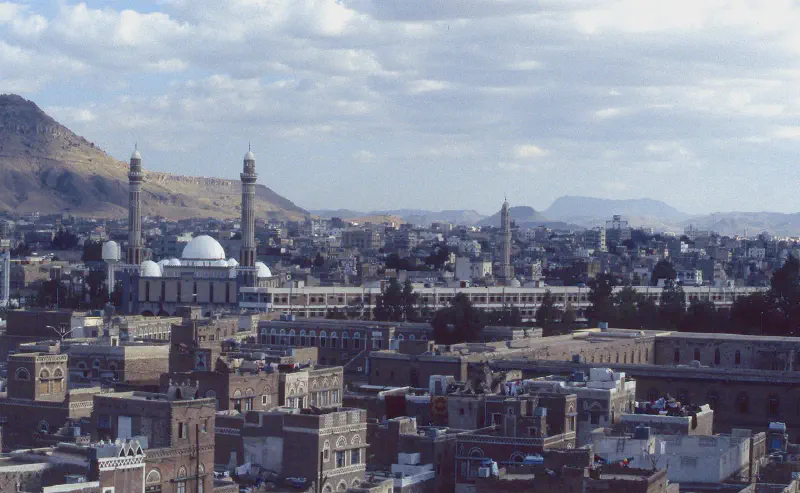
The capital city of Sana’a in 1996. Built in a mountain valley at an altitude of 2,200 m, Sana’a has been inhabited for more than 2,500 years. In the 7th and 8th centuries, the city became an important center for the spread of Islam. We find this religious and political heritage in its 106 mosques, its 12 hammams and its 6,500 houses, all of which date from before the 11th century. The tower houses with many floors and the old adobe houses further add to the beauty of the site. Source: Werner Bayer
Although AQAP is essentially a foreign group to Yemen, the terrorist cell has ultimately started a chain reaction of the ‘accidental guerilla’ as outlined by David Kilcullen. The ideology of al-Qaeda or AQAP might not be appealing to natives of Yemen but the violent “backlash” from state governments in combating guerrilla fighting creates the “majority of [al-Qaeda’s] strength” (Kilcullen 2009, 34). Throughout the years of conflict with AQAP, Yemen has lost territory, regained territory, faced kidnappings, bombings, suicide bombings, and assassination attempts. One of the most brazen was a suicide bombing that left 96 soldiers dead only a short distance from the presidential palace (Sohlman 2012, 250). The response from government forces to such widespread actions is undoubtedly equal in scope and severity. The same phenomenon occurs with AQAP and native reactions to false imprisonment and violent drone strikes from external actors. When an individual’s entire family is killed from a drone strike or is falsely imprisoned to meet external ‘goals,’ levels of animosity will increase. Or, at the very least, the tacit approval of insurgencies becomes more pronounced.
However, some scholars disagree on the domestic perception of AQAP. Sarah Phillips notes that the “grassroots support” of AQAP is not as broad as many believe and the group’s ideology is not compatible with the domestic audience of Yemen (2011, 98). Rather than condemn the success of AQAP, Phillips recognizes Kilcullen’s phenomenon of the ‘accidental guerilla’ that results from blowback during disproportionate violence. The only way to get around this accidental characteristic is the establishment of a “legitimate and effective government” (2011, 99). Although not impossible, such a path would be beyond the ability of modern international relations. More to Phillips’ point is the isolation of government action as the primary source of antagonization in polarizing domestic audiences against state legitimacy. Without disproportionate violence from the state the presence of an insurgency such as AQAP would be less pronounced. The state can therefore be identified as exacerbating the problem into a more complicated problem in attempting to solve the original problem of insurgency.
Being falsely arrested by the state would reinforce sympathies with insurgent causes for many individuals. A young male ripped from his home would strip many households of their primary source of labor and income due to the traditional nature of many Yemeni families. The substantial loss of domestic stability would have many families reeling through lost harvests and untended trades sitting idle. The young men themselves would end up in close proximity to actual criminals and terrorist members that could potentially influence their formerly innocent habits and ideology. Actual terrorists that attempted to sympathize with innocent prisoners would have the compounded effect of empathy wherein they are both members of the prison system. As innocent people entered the prison system in Yemen they might not have supported al-Qaeda but “they probably did by the time they were released (Hellmich 2012, 626). The callous conduct by Yemeni state officials dismissed the potentiality of disenfranchising a whole swath of their citizens. Yemen showed actionable conduct for US officials only at the cost of “those falsely arrested becoming more sympathetic to the terrorists’ cause” (Hellmich 2012, 626). No longer would the young man in a distant settlement be politically neutral when witnessing the conflict between insurgent AQAP members and Yemeni state forces. This individual might not become operational and participate in the conflict but the complete erosion of political will dangerously forces state resources to depend entirely on external foreign assistance. All these domestic costs were extracted at the price of US non-intervention in troubled Yemen and the maintenance of plentiful US foreign aid. This, of course, lasted only until the US saw AQAP as a non-threat in Yemen and withdrew much of its aid in 2005, as previously explained.
“Innocent People Will Die”
In addition to the Yemeni military, the US military conducts operations in the conflict with AQAP by using unmanned aerial vehicles for reconnaissance and direct action. These drones operate through remote control and can provide accurate aerial intelligence in addition to being able to deliver substantial firepower to remote locations. Using more direct sources of physical violence, including special operations, have been determined to reduce the Yemeni government’s political legitimacy (Katz 2003, 42). Citizens view their central government as incapable of combatting a few hundred or thousand terrorists and must rely on the might of a foreign power to stay ahead. This effect would be magnified if there were actual US military personnel acting in a combat role within Yemen. It is therefore useful for the US to create a mechanical buffer zone with drones in order to avoid the political fallout. A better resolution would be the fortification of Yemeni military capabilities in combating AQAP independent of US drone campaigns. However, many US officials would be skeptical of Yemeni capabilities without US drone strike capabilities and other methods of guaranteeing security would have to be developed. Despite the rough transition period of moving away from drone strikes, the reclamation of independent Yemeni military capabilities would improve the political legitimacy of the regime enough for the difficulties to be worth it.
The tribal region of Pakistan has been the most identifiable area of operations for drones in the media. This might have been accurate for ongoing US operations until 2012 when the number of drone strikes in Yemen surpassed the numbers in Pakistan. By the summer of 2012 there had been 23 drone strikes in Yemen during the year while Pakistan had 22 (Ackerman and Shactman 2012). Since 2002 there have been 154 drone strikes in Yemen with approximately 800 casualties including 97 civilians. (Murray 2013). Drones are not limited to operations with Yemen or the Middle East and have become the poster child for a new incarnation of modern war. However, these tools are not used indiscriminately, as all drone operations in Yemen are approved by Yemeni officials (Rohde 2012). On a US policy level, all drone strikes are individually approved by the US President (Becker and Shane 2012). With such requirements for drone strikes it is difficult to imagine weighing the costs and benefits of certain sets of intelligence when in reality there could be a number of innocent bystanders.
The greatest mishap of utilizing drone strikes is not the determination of their effectiveness but their overall use. In an interview, former President Bill Clinton stated that no matter the precision of your weapons, “when you set them off, innocent people will die” (Coll 2004, 536). The former Vice Chairman of the Joint Chiefs of Staff, General Cartwright, has shared this sentiment recently. In a 2013 address to the Chicago Council on Global Affairs he stated he was seeing “blowback” effects due to the War on Terror drone campaign (Mazzetti and Shane 2013). It does not matter if the perceived validity of intelligence is nearly irrefutable there still exists a chance of error. This margin of error might represent half of a family ripped apart by the ‘precision’ of a laser guided missile. Guerrilla fighter expert David Kilcullen relates a prediction by Qiao Liang that states that the US must follow its defined rules or the “whole world won’t trust it” (2009, 7). It is with this estimation that the US is treading a very fine line between punishing the killers of innocent civilians while unintentionally becoming guilty of the same type of crime. This very line was tragically crossed in the summer of 2013, when three suspected members of al-Qaeda confronted a cleric behind a Mosque a US drone strike killed them all (Murray 2013). This might seem successful if the fact that the cleric just finished an aggressive sermon denouncing al-Qaeda was ignored. In an effort to exterminate members of al-Qaeda the US inadvertently murdered perhaps one of the driving forces behind anti-terrorism with the community. The community was in the beginning stages of slowly departing from al-Qaeda ideologically but is now in the midst of questioning state actions. This example is reflective in the greater difficulty the US is having in conducting effective military action with drones. One journalist even described it as the US helping Yemen with one hand while killing it with the other (al-Muslimi 2013). The Yemeni regime is not immune to this interpretation either. When President Abed Hadi met with the US CIA director a total of two drone strikes occurred during the time of the meeting (al-Muslimi 2013). While the timing may be a coincidence the interpretation by Yemeni citizens was that Hadi was becoming a US yes-man (al-Muslimi 2013).
The implications for waning legitimacy are profound. US drone strike actions are tearing away its image in the eyes of the public. Such was the case when Farea al-Muslimi was able to testify before the US Congress earlier this year. In his testimony al-Muslimi was able to project the sentiments of his home villagers following the drone strike that killed a member of AQAP. Instead of arresting the man, al-Muslimi stated what terrorist propaganda could not achieve was instead accomplished “in one instant” by “one drone strike” (Savage 2013). Warping the rule of law in the eyes of Yemenis has seriously damaged the perceived legitimacy of US interests and in turn, to Yemeni state interests. The below U.S. State Department polling results reflect this public perception reality about U.S. military action within Yemen (Sharp 2012, 19).
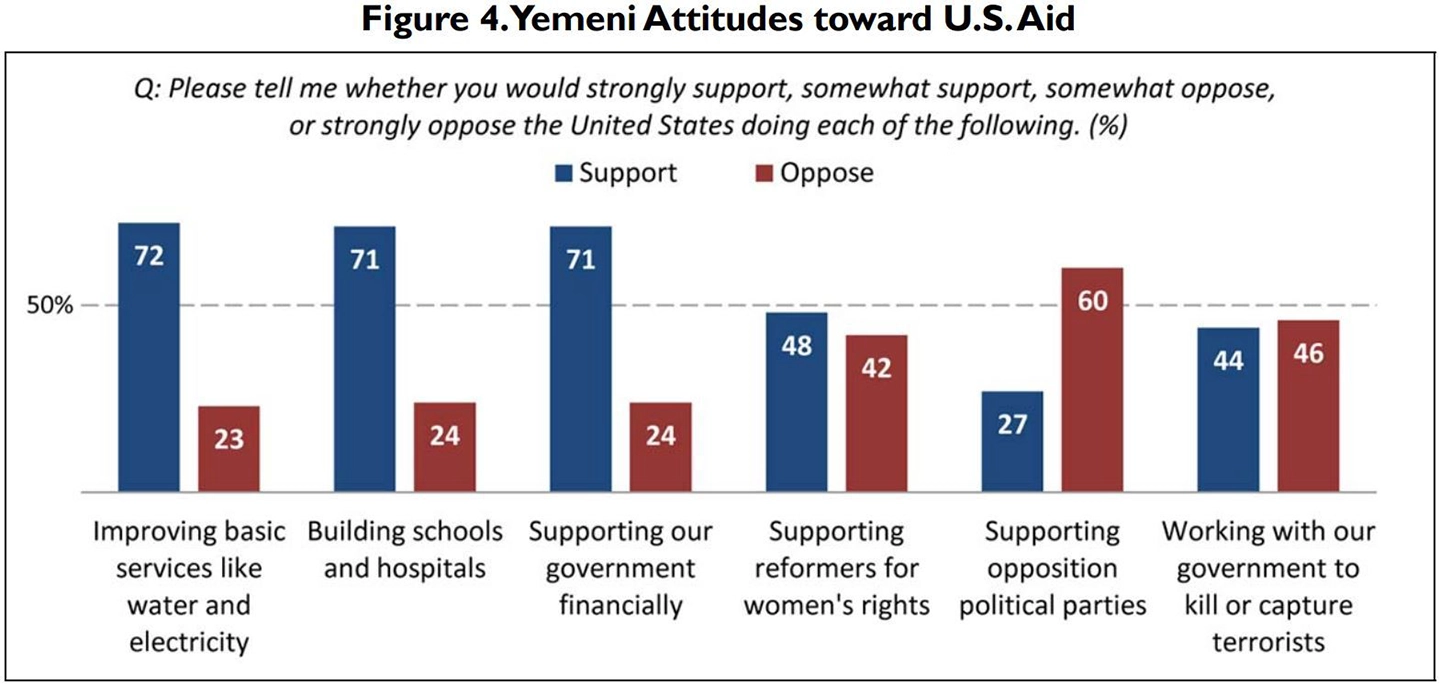
Conclusion
The conflict between AQAP, Yemen, and the US has highlighted significant problems with external foreign aid and its effectiveness. The actions of the insurgent group AQAP has had a profound impact on the domestic and international relations of Yemen and the US. The US and Yemen have not been idle to these threats and have dramatically shifted their level of action within the region. However, these actions have proven ineffective and sometimes even counterproductive to effectively combating the danger and abilities of AQAP. The shadows of US foreign aid constraints on the Yemeni government are counterproductive to effectively combating AQAP and undermine the capabilities of the Yemeni state. Conduct by states within the Yemen conflict has seriously changed public perception. Unfortunately this public perception has mostly been migrated to a negative outlook. Some of these state actions are sadly justified due to the nature of poverty within Yemen. However, in the attempt to secure foreign aid from the US the Yemeni government dismissed more important domestic considerations. Additionally, the method of gaining such foreign aid with ‘dragnet’ policing effectively alienated a large demographic of citizens. Such motivational themes have seriously diminished the political legitimacy of the Yemeni regime. If US foreign aid was used to improve the quality of life for the majority of the domestic audience the outlook could be different but this is unfortunately not the case.
External actions by US interests also prove problematic for ‘winning’ the conflict in Yemen. The efforts of drone strikes are ambitious in their aim at exterminating AQAP operatives but innocent casualties hinder the overall mission. This is especially compounded when town leaders are killed who were advocating anti-al-Qaeda ideology. Reactions by fellow townspeople are logically confused as to the aims of the US drone campaign. Although a strike may kill many more operatives than civilians the innocent deaths have significant impact nonetheless. Regular citizens are able to see the contradictory pursuits of punishing murderers while carrying a margin of error in committing murder anew. Overall, the pursuits of US foreign aid and policy in Yemeni are substantially constraining the national government in their ability to meet domestic needs and systemic requirements while combating AQAP.
References
- Ackerman, S. & Shactman, N. (2012, June 14). Let’s admit it: The US is at war in Yemen, too. Wired. Retrieved from http://www.wired.com/dangerroom/2012/06/yemen-war/all/
- al-Maqtari, M. (2012, April 12). Oil in Yemen to run out in 12 years. Yemen Times. Retrieved from http://www.yementimes.com/en/1563/news/696/Oil-in-Yemen-to-run-out-in-12-years.htm
- Almasmari, H. (2012, Oct 5). Ahmed al-bahri expert in houthi affairs. Yemen Post. Retrieved from http://yemenpost.net/Detail123456789.aspx?ID=3&SubID=1723&MainCat=4
- al-Muslimi, F. (2013, August 11). America loses Yemeni people in drone war. Al Monitor. Retrieved from http://www.al-monitor.com/pulse/originals/2013/08/america-loses-face-with-yemeni-1.html
- al-Qaeda said to seize Yemen town amid turmoil. (2011, March 26). CBS News. Retrieved from http://www.cbsnews.com/2100-202_162-20047565.html
- al-Shamahi, A. (2012, Sept 24). Is aid good for yemen?. The Guardian, Retrieved from http://www.theguardian.com/global-development/poverty-matters/2012/sep/24/yemen-foreign-aid-good-debate
- Becker, J., & Shane, S. (2012, May 29). Secret ‘kill list’ proves a test of Obama’s principles and will. New York Times. Retrieved from http://www.nytimes.com/2012/05/29/world/obamas-leadership-in-war-on-al-qaeda.html?_r=0&pagewanted=all
- Boucek, C. House Committee on Homeland Security, Subcommittee on Counterterrorism and Intelligence. (2011). Terrorist threat to the U.S. homeland – al-qaeda in the arabian peninsula (aqap). Washington, D.C.: Carnegie Endowment for International Peace.
- Carapico, S. (2006). No Quick Fix: Foreign Aid and State Performance in Yemen. Short of the Goal: US Policy and Poorly Performing States, Washington: Center for Global Development, 182-208.
- Cleveland, W., & Bunton, M. (2009). A history of the modern middle east. (4th ed ed.). Boulder: Westview Press.
- Cloud, D., & Dilanian, K. (2012, May 16). U.S. escalates clandestine war in yemen. Los Angeles Times. Retrieved from http://latimesblogs.latimes.com/world_now/2012/05/washington-escalation-american-clandestine-war-yemen-us-troops-.html
- Coll, S. (2004). Ghost wars. New York: Penguin Books.
- Dana, P. (2010, January 27). U.S. military teams, intelligence deeply involved in aiding yemen on strikes. Washington Post. Retrieved from http://www.washingtonpost.com/wp-dyn/content/article/2010/01/26/AR2010012604239.html
- Redwan, M. (2009, November 19). Pity those caught in the middle. Economist, Retrieved from http://www.economist.com/node/14920092?story_id=14920092
- DeYoung, K. (2010, May 16). President obama executive order gives treasury authority to freeze yemeni assets in U.S. Washington Post. Retrieved from http://www.washingtonpost.com/world/national-security/president-obama-executive-order-will-give-treasury-authority-to-freeze-us-based-assets-in-yemen/2012/05/15/gIQALWPUSU_story.html
- Downes, C. (2004). ’targeted killings’ in an age of terror: The legality of the Yemen strike. Journal of Conflict & Security Law, 9(2), 277-294.
- Fontaine, R., & Exum, A. (2010, January 5). Yemen’s coming disaster. Los Angeles Times. Retrieved from http://articles.latimes.com/2010/jan/05/opinion/la-oe-fontaineexum5-2010jan05
- Freeman, J. (2009). The al Houthi insurgency in the north of yemen: An analysis of the shabab al moumineen. Studies in Conflict & Terrorism, 32(11), 1008-1019.
- Ghobari, M., & Sudam, M. (2011, January 20). Protests erupt in Yemen, president offers reform. Reuters. Retrieved from http://af.reuters.com/article/tunisiaNews/idAFLDE70J2BZ20110120?pageNumber=3&virtualBrandChannel=0&sp=true
- Hegre, H. (2004). The duration and termination of civil war. Journal of Peace Research, 41(3), 243–252.
- Hellmich, C. (2012). Fighting al qaeda in yemen? rethinking the nature of the islamist threat and the effectiveness of U.S. counterterrorism strategy. Studies in Conflict & Terrorism, 35(9), 618-633.
- Hill, G. (2010). Yemen: Fear of failure. Chatham House: Middle East and North Africa Programme, MENAP BP 2010(1).
- Johnsen, G. (2013). The last refuge. New York: W. W. Norton & Company.
- Johnsen, G. (2007). Yemen accuses Iran of meddling in its internal affairs. Terrorism Focus, 4(2), 3-4.
- Katz, M. (2003). Breaking the Yemen-al Qaeda connection. Current History, 102(660), 40-43.
- Katzman, K. Congressional Research Service, Foreign Affairs, Defense, and Trade Division. (2005). Al qaeda: Profile and threat assessment (RL33038).
- Kilcullen, D. (2009). The accidental guerrilla. New York: Oxford University Press.
- Lacina, B. (2006). Explaining the severity of civil wars. Journal of Conflict Resolution, 50(2), 276–289.
- Mason, T. D. (2009). The evolution of theory on civil war and revolution. In M. Midlarsky (Ed.), Handbook of War Studies III: The Intrastate Dimension (p. 63–99). Ann Arbor, MI: University of Michigan Press.
- Mazzetti, M, and S Shane. “As New Drone Policy Is Weighed, Few Practical Effects Are Seen.” The New York Times 21 Mar. 2013: n. pag. Web.
- Meernik, J., & Brown, C. (2007). The short path and the long road: Explaining the duration of US military operations. Journal of Peace Research, 44(1), 65-80.
- Murray, R. (2013, June 7). Anger at us drone war continues in yemen. Al Jazeera. Retrieved from http://www.aljazeera.com/indepth/features/2013/06/201365122319329623.html
- Phillips, S. (2011). Al-qaeda and the struggle for yemen. Survival: Global Politics and Strategy, 53(1), 95-120.
- Plaut, M. (2008, November 20). Yemen ‘faces crisis as oil ends’. BBC. Retrieved from http://news.bbc.co.uk/2/hi/middle_east/7739402.stm
- Redwan, M. (2009, Nov 19). Yemen’s war: Pity those caught in the middle. Economist, Retrieved from http://www.economist.com/node/14920092?story_id=14920092
- Rohde, D. (2012). The Obama doctrine. Foreign Policy, April, Retrieved from http://www.foreignpolicy.com/articles/2012/02/27/the_obama_doctrine?page=full
- Rollins, J. (2011). Al Qaeda and affiliates: Historical perspective, global presence, and implications for U.S. policy (7-5700R41070). Congressional Research Service.
- Ross, M. L. (2005). Resources and rebellion in aceh, indonesia. In P. Collier & N. Sambinas (Eds.), Understanding Civil War: Volume 2 (pp. 35-58). Washington, DC: World Bank.
- Savage, C. (2013, April 23). Drone strikes turn allies into enemies, Yemeni says. New York Times. Retrieved from http://www.nytimes.com/2013/04/24/world/middleeast/judiciary-panel-hears-testimony-on-use-of-drones.html?_r=0
- Schneider, G., Banholzer, L., & Haer, R. (2011). Cain’s choice: Causes of one-sided violence against civilians. In J. T. Georg (Ed.), War: An Introduction to theories and Research on Collective Violence (p. 57–82). Hauppauge, NY: Nova Science Publishers.
- Sharp, J. Congressional Research Service, Middle Eastern Affairs. (2012). Yemen: Background and U.S. relations (7-5700 RL34170).
- Sharp, J. Congressional Research Service, Middle Eastern Affairs. (2014). Yemen: Background and U.S. relations (7-5700 RL34170).
- Sinjab, L. (2011, February 3). Yemen protests: 20,000 call for president saleh to go. BBC. Retrieved from http://www.bbc.co.uk/news/world-middle-east-12353479
- Sohlman, E. (2012). Al Qaeda in Yemen pushed back, but terrorism threat remains strong. Journal of the National Committee on American Foreign Policy,34(5), 249-254.
- Stanton, K. (2005, January 5). Thwarted bomb attack points spotlight at yemen. PBS. Retrieved from http://www.pbs.org/newshour/extra/features/world/jan-june10/yemen_01-05.html
- Is south yemen preparing to declare independence? (2011, July 8). Time. Retrieved from http://www.time.com/time/world/article/0,8599,2081756,00.html
- U.S. Department of State, Bureau of Near Eastern Affairs. (2013). U.S. relations with yemen. Retrieved from website: http://www.state.gov/r/pa/ei/bgn/35836.htm
- Winter, L. (2010). Fragile state: Yemen in conflict. Current History, 109(731), 395-400.
- Whitlock, C., & Tate, J. (2011, July 19). U.S. increases planned aid to yemen in fight against al-qaeda. Washington Post. Retrieved from http://www.washingtonpost.com/world/national-security/us-increases-planned-aid-to-yemen-in-fight-against-al-qaeda/2012/07/19/gJQAj3HsvW_story.html
- “Yemen, Rep. Data.” . The World Bank. 2014. Web. 3 May 2014. http://data.worldbank.org/country/yemen-republic#cp_fin.
- Yemen’s Saleh agrees to transfer power. (2011, November 24). Al Jazeera. Retrieved from http://www.aljazeera.com/news/middleeast/2011/11/2011112355040101606.html
- Yemen profile. (2012, September 12). BBC. Retrieved from http://www.bbc.co.uk/news/world-middle-east-14704951